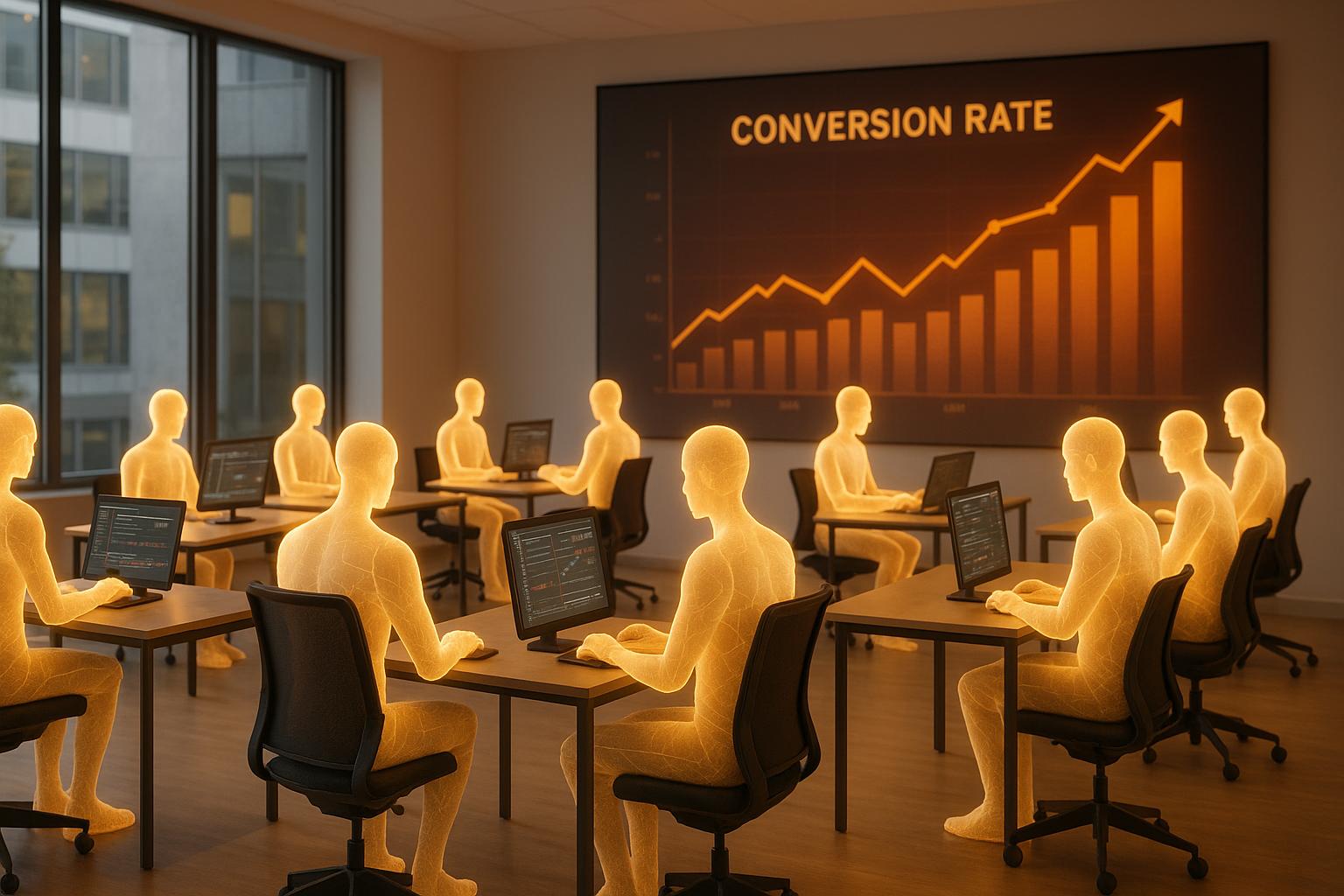Want to sell your SaaS company for 7x ARR? Here's what you need to know:
By 2025, SaaS companies with strong fundamentals, AI-driven efficiency, and scalable ARR are landing premium deals. Investors are prioritizing predictable revenue, customer retention, and growth potential.
Key takeaways:
- 7x ARR is achievable: High retention, rapid growth (40%+ ARR), and AI integration are critical.
- Economic recovery boosts M&A: Lower borrowing costs mean more competition for top SaaS companies.
- AI drives valuations: Tools that cut costs, improve customer success, and enhance scalability attract buyers.
- Public vs. private valuations: Private SaaS firms can close the valuation gap by excelling in metrics like gross margins (70%+) and ARR growth.
Start planning 12–18 months before your exit to maximize value. A well-prepared SaaS business with strong metrics and market positioning can secure standout results.
The State of SaaS in 2025: Multiples, Growth Strategies, Valuations, & Exit Planning
Market Trends Driving SaaS Exit Multiples in 2025
Shifting economic and industry dynamics are shaping an environment where SaaS companies have a chance to secure higher exit multiples. By understanding these trends, founders can better position their businesses to align with market demands and attract interest from potential buyers. Let’s break down the key factors influencing these valuations.
Economic Recovery and M&A Activity
Improved financing conditions have given a boost to mergers and acquisitions (M&A) within the SaaS sector. Lower borrowing costs make it easier for private equity firms and strategic buyers to fund larger deals, leading to increased competition for high-performing SaaS companies. This heightened demand is pushing valuations higher, especially for businesses with strong financial metrics. The interplay between private and public markets adds another layer to this dynamic.
Public vs. Private SaaS Valuations
Public SaaS companies typically achieve higher revenue multiples compared to their private counterparts. This gap creates opportunities for private firms that are well-prepared to leverage their strengths. Strategic acquirers often use public market valuations as benchmarks to justify paying higher prices, while private equity buyers tend to focus on operational performance and growth potential. SaaS companies with reliable recurring revenue and solid financial health are in the best position to negotiate higher multiples.
AI and Technology Changes in SaaS
The integration of artificial intelligence is becoming a key factor in SaaS valuations. Companies that embed AI into their core offerings are seen as more competitive and capable of delivering better results for customers. AI applications in areas like customer success, sales forecasting, and churn reduction not only improve efficiency but also enhance scalability. Additionally, leveraging AI to lower customer acquisition costs and boost customer lifetime value is increasingly attractive to buyers. As due diligence processes become more sophisticated, buyers are placing greater emphasis on data quality and a strong AI infrastructure, both of which reduce risks and support faster post-acquisition growth.
How to Achieve 7x ARR Multiples
Reaching 7x ARR multiples requires a mix of rapid growth, operational efficiency, and smart positioning in the market. These factors come together to create investment opportunities that attract top-tier valuations. Here’s how to align your business strategy to hit this ambitious target.
Revenue Growth and Retention Numbers
Strong revenue growth and retention metrics are the backbone of high valuations. Buyers are drawn to companies that demonstrate consistent growth while scaling, combining this with excellent customer retention for maximum appeal.
- Retention matters: High net and gross revenue retention rates show a strong product-market fit and signal customer satisfaction. This also boosts customer expansion and ensures predictable growth, reducing dependence on acquiring new customers.
- Consistent MRR growth: Monthly recurring revenue (MRR) growth reflects a scalable sales process and healthy market demand. Buyers typically look at several years of data to confirm that growth is sustainable.
- Diversified customer base: Keeping customer concentration risk low - especially across different market segments - adds stability. This is particularly valuable when enterprise clients with large contracts are involved.
Using AI to Improve Operations
AI can be a game-changer when it comes to operational efficiency. Leveraging AI tools not only cuts costs but also strengthens your pitch to potential buyers by showcasing advanced capabilities.
- Smarter workflows: AI-powered tools can handle everything from health scoring to sales forecasting and dynamic pricing. These tools help identify at-risk accounts, provide accurate revenue predictions, and optimize pricing strategies to maximize revenue per customer.
- Scalable customer operations: Automated support systems like chatbots and AI-driven onboarding processes improve efficiency without adding headcount, keeping unit economics in check while maintaining high service quality.
- Data-driven product development: Predictive analytics can guide your team in prioritizing features based on user behavior and market trends. This ensures that development efforts are focused on what matters most, delivering high-impact results.
By integrating AI into your operations, you not only streamline processes but also position your company as forward-thinking - an attractive quality for acquirers.
Market Positioning and Product Design
How you position your product and design your platform can significantly influence your valuation.
- API-first and modular design: Products that are easy to integrate and adopt incrementally lower barriers for customers and support land-and-expand strategies. These features are highly valued by buyers.
- Niche leadership: Dominating a specific vertical market often leads to higher multiples, thanks to reduced competition, specialized expertise, and higher switching costs for customers.
- Platform ecosystems: A strong ecosystem with active third-party developers creates network effects, improving retention and making your product more defensible in the market.
- Data network effects: Products that get better with increased usage build competitive advantages over time. Combined with robust compliance and security measures, they open doors to enterprise adoption and global growth.
Strategic product design and market positioning don’t just attract buyers - they instill confidence, making it easier to command premium valuations. By focusing on these areas, you can set your company up for a standout exit.
sbb-itb-9cd970b
How Top SaaS & AI Tools Directory Helps SaaS Success
Achieving a 7x ARR exit requires more than just ambition - it takes the right tools to drive growth. The Top SaaS & AI Tools Directory acts as a marketplace, offering solutions tailored to help founders improve key metrics in lead generation, sales, and operational performance.
Boosting Lead Generation and Sales
Revenue growth is a cornerstone of high exit multiples, and the tools featured in the directory are designed to make this process more efficient. With AI-powered lead generation tools, SaaS companies can enhance customer acquisition efforts and streamline sales operations. CRM and automation tools listed in the directory help create predictable revenue streams, ensuring steady monthly recurring revenue. These tools also enable companies to build scalable sales systems that directly impact valuations. To complement this, the directory includes analytics tools that fine-tune sales strategies and improve overall operational performance.
Leveraging AI Analytics for Business Growth
Beyond sales, advanced analytics tools in the directory provide valuable insights into the business. Understanding metrics like customer acquisition cost and gross margins is crucial for achieving premium exit multiples. The AI analytics tools help track these metrics in real-time, identify bottlenecks in sales funnels, and refine pricing strategies. Additionally, AI-powered solutions for marketing automation and content creation allow companies to control costs without compromising on customer experience. Together, these tools help SaaS businesses maintain operational efficiency, which plays a key role in building a strong, attractive business profile.
Key Steps for Securing Premium SaaS Exits
Securing a 7x ARR exit by 2025 requires careful planning and execution across multiple areas. Data suggests that starting preparations 12–18 months in advance can increase your valuation multiple by 1–2x [5]. Early, strategic planning is critical to achieving top-tier outcomes. Here's how to align your financial and operational metrics to secure a premium exit.
Start by tightening your financial fundamentals. Focus on the metrics that drive valuations. As of early 2025, the SaaS Capital Index shows a median valuation multiple of 7.0 times current run-rate annualized revenue [1]. Companies in the top performance quartile can push this multiple into the 7–9x range [5]. To reach this level, aim for gross margins above 70% and positive EBITDA margins, which hit 7% in Q1 2024 [4][6].
Aggressive growth is essential for commanding higher multiples. Private SaaS companies with ARR growth rates exceeding 40% can achieve multiples between 7x and 10x ARR [2][3]. For those with more moderate growth (20–40%), multiples typically fall between 5x and 7x ARR. This highlights the importance of prioritizing rapid growth during your scaling phase.
Vertical specialization can also drive higher valuations. SaaS companies focusing on niche industries like healthtech, fintech, or construction tech often command premiums, with vertical solutions averaging 7.8x ARR [5]. This strategy requires deep industry expertise but can significantly enhance your valuation compared to horizontal SaaS solutions.
Strategic acquirers are key players in the market. In 2025, strategic buyers accounted for 62% of lower middle market SaaS deals, up from 55% in 2023, and they typically pay 1.5–2.0x premiums over Private Equity for comparable deals [5]. Strategic acquirers value factors like customer synergies, opportunities for technology integration, and market expansion potential. Aligning your company’s strengths with these priorities can significantly impact your final multiple and strengthen your overall exit narrative.
Operational efficiency is another critical factor. Companies that combine strong growth with disciplined operations are securing the highest valuations. Using AI and automation tools to streamline processes can help maintain healthy unit economics, predictable revenue streams, and scalable operations that don’t require proportional increases in headcount as revenue grows.
Finally, bridge the gap between public and private valuations. While lower middle market SaaS companies trade at 4.6x revenue, compared to 7.4x for public peers - a 38% discount [5] - exceptional companies can close this gap by excelling in metrics and strategic positioning. This creates opportunities for well-prepared SaaS businesses to achieve standout results during an exit.
FAQs
What steps can SaaS founders take to secure a 7x ARR exit in 2025?
To aim for a 7x ARR exit by 2025, SaaS founders should prioritize steady revenue growth, high customer retention, and efficient operations. These are the core factors that investors look for when determining valuation.
Make sure your business is ready to scale by simplifying workflows, documenting clear standard operating procedures (SOPs), and using AI-powered tools to enhance efficiency. Keep an eye on profitability by cutting unnecessary costs and maintaining a strong financial foundation.
On top of that, focus on building a loyal customer base and showing that your company can adapt to changing market demands. A business that's well-prepared and aligned with market trends will stand out in the competitive M&A space, making it more likely to attract top-tier offers.
How does adding AI to a SaaS business model boost its valuation and appeal to buyers?
Integrating AI into a SaaS business model can significantly increase its value and appeal to potential buyers. By 2025, investors are focusing on companies that use AI to deliver scalable, data-driven solutions that stand out in the market. This not only highlights advanced product capabilities but also underscores the potential for sustained growth and industry impact.
SaaS businesses powered by AI often command higher exit multiples. Why? They bring unique intellectual property, streamline operations, and deliver clear, measurable benefits to customers. These qualities position them as prime candidates in the mergers and acquisitions (M&A) space, giving founders a stronger edge when negotiating premium deals.
Why should private SaaS companies prioritize metrics like gross margins and ARR growth to increase their valuation?
Private SaaS companies should prioritize gross margins and ARR (Annual Recurring Revenue) growth, as these metrics play a crucial role in showcasing profitability and scalability - two elements that significantly impact a company’s valuation. Strong gross margins indicate that a business is running efficiently and has the potential to generate healthy profits, which naturally makes it more appealing to investors.
At the same time, steady ARR growth demonstrates consistent revenue increases and solid market demand, both of which are essential for standing out in a crowded industry. Focusing on these metrics allows private SaaS companies to align more closely with the valuation standards of public companies, helping them bridge the gap and secure better deals.
Related posts
- This founder literally sold his SaaS for 8.5x revenue after implementing these 3 AI systems
- I analyzed 50+ SaaS exits from the last 6 months. Companies with AI automation sold for 3.2x higher multiples. Here's the exact playbook
- "How our AI exit optimization system helped 12 SaaS companies exit for 3-5X industry average"
- How AI Systems Add 3.2x to SaaS Valuations And What Buyers Look For



